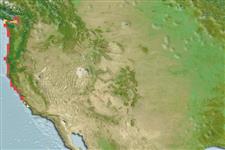>
Ovalentaria/misc (Various families in series Ovalentaria) >
Embiotocidae (Surfperches)
Etymology: Amphistichus: Greek, amphi = on both sides + Greek, stix, -ichos = row (Ref. 45335); rhodoterus: From 'rodoteros' meaning rosy (Ref. 6885).
More on author: Agassiz.
Environment: milieu / climate zone / depth range / distribution range
Ökologie
seewasser; brackwasser demersal; tiefenbereich 0 - 7 m (Ref. 2850). Temperate; 50°N - 34°N, 126°W - 119°W
Eastern Pacific: Vancouver Island, British Columbia, Canada to Avila Beach, central California, USA.
Size / Gewicht / Alter
Maturity: Lm ? range ? - ? cm
Max length : 41.0 cm TL Männchen/unbestimmt; (Ref. 2850); max. veröff. Alter: 9 Jahre (Ref. 56049)
Rückenflossenstacheln (insgesamt) : 9 - 10; Rückenflossenweichstrahlen (insgesamt) : 25 - 28; Afterflossenstacheln: 3; Afterflossenweichstrahlen: 28 - 31. Caudal fin broadly forked (Ref. 6885). Generally silvery overlaid lightly with a brassy cast; light green above; sides with a series of about 9 to 11 narrow vertical dark bars, posteriorly, broken and staggered along the lateral line; caudal and anal fins red (Ref. 6885).
Adults are found in sand beaches in surf on exposed coast, sometimes in bays and backwaters (Ref. 2850). Viviparous, female carries the developing young (Ref. 205).
Viviparous, female carries the developing young (Ref. 205).
Eschmeyer, W.N., E.S. Herald and H. Hammann, 1983. A field guide to Pacific coast fishes of North America. Boston (MA, USA): Houghton Mifflin Company. xii+336 p. (Ref. 2850)
IUCN Rote Liste Status (Ref. 130435: Version 2024-2)
Bedrohung für Menschen
Harmless
Nutzung durch Menschen
Fischereien: kommerziell; Sportfisch: ja; Aquarium: Öffentliche Aquarien
Tools
Zusatzinformationen
Download XML
Internet Quellen
Estimates based on models
Preferred temperature (Ref.
123201): 10.3 - 14, mean 12.1 °C (based on 57 cells).
Phylogenetic diversity index (Ref.
82804): PD
50 = 0.6250 [Uniqueness, from 0.5 = low to 2.0 = high].
Bayesian length-weight: a=0.01413 (0.00848 - 0.02352), b=3.00 (2.85 - 3.15), in cm total length, based on LWR estimates for this species & (Sub)family-body (Ref.
93245).
Trophic level (Ref.
69278): 3.4 ±0.5 se; based on diet studies.
Widerstandsfähigkeit (Ref.
120179): mittel, Verdopplung der Population dauert 1,4 - 4,4 Jahre. (tm=3; tmax=9; Fec=39).
Fishing Vulnerability (Ref.
59153): Low to moderate vulnerability (31 of 100).
